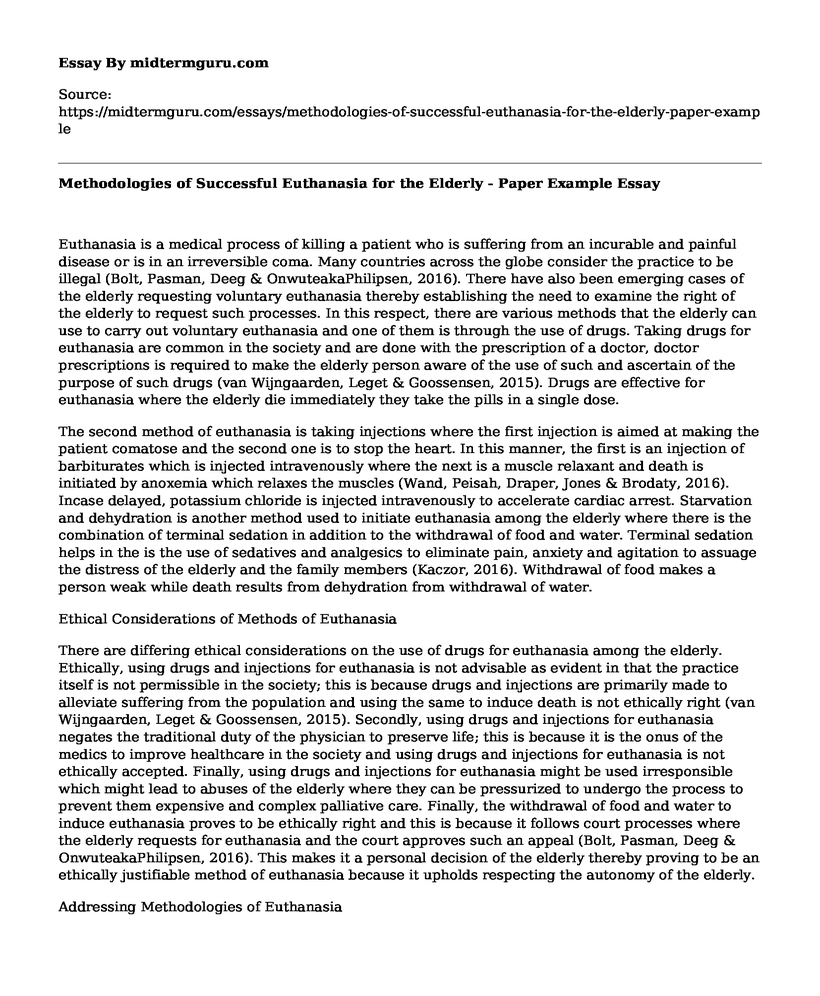Euthanasia is a medical process of killing a patient who is suffering from an incurable and painful disease or is in an irreversible coma. Many countries across the globe consider the practice to be illegal (Bolt, Pasman, Deeg & OnwuteakaPhilipsen, 2016). There have also been emerging cases of the elderly requesting voluntary euthanasia thereby establishing the need to examine the right of the elderly to request such processes. In this respect, there are various methods that the elderly can use to carry out voluntary euthanasia and one of them is through the use of drugs. Taking drugs for euthanasia are common in the society and are done with the prescription of a doctor, doctor prescriptions is required to make the elderly person aware of the use of such and ascertain of the purpose of such drugs (van Wijngaarden, Leget & Goossensen, 2015). Drugs are effective for euthanasia where the elderly die immediately they take the pills in a single dose.
The second method of euthanasia is taking injections where the first injection is aimed at making the patient comatose and the second one is to stop the heart. In this manner, the first is an injection of barbiturates which is injected intravenously where the next is a muscle relaxant and death is initiated by anoxemia which relaxes the muscles (Wand, Peisah, Draper, Jones & Brodaty, 2016). Incase delayed, potassium chloride is injected intravenously to accelerate cardiac arrest. Starvation and dehydration is another method used to initiate euthanasia among the elderly where there is the combination of terminal sedation in addition to the withdrawal of food and water. Terminal sedation helps in the is the use of sedatives and analgesics to eliminate pain, anxiety and agitation to assuage the distress of the elderly and the family members (Kaczor, 2016). Withdrawal of food makes a person weak while death results from dehydration from withdrawal of water.
Ethical Considerations of Methods of Euthanasia
There are differing ethical considerations on the use of drugs for euthanasia among the elderly. Ethically, using drugs and injections for euthanasia is not advisable as evident in that the practice itself is not permissible in the society; this is because drugs and injections are primarily made to alleviate suffering from the population and using the same to induce death is not ethically right (van Wijngaarden, Leget & Goossensen, 2015). Secondly, using drugs and injections for euthanasia negates the traditional duty of the physician to preserve life; this is because it is the onus of the medics to improve healthcare in the society and using drugs and injections for euthanasia is not ethically accepted. Finally, using drugs and injections for euthanasia might be used irresponsible which might lead to abuses of the elderly where they can be pressurized to undergo the process to prevent them expensive and complex palliative care. Finally, the withdrawal of food and water to induce euthanasia proves to be ethically right and this is because it follows court processes where the elderly requests for euthanasia and the court approves such an appeal (Bolt, Pasman, Deeg & OnwuteakaPhilipsen, 2016). This makes it a personal decision of the elderly thereby proving to be an ethically justifiable method of euthanasia because it upholds respecting the autonomy of the elderly.
Addressing Methodologies of Euthanasia
In response to the conflicting views regarding ethics of different methodologies of euthanasia, researchers need to consider various issues when deciding on the right methods to use on the elderly. One issue should be respect for autonomy and any decision to be made regarding euthanasia for the elderly need to be congruent with wishes of the person. Secondly, any method used must be in line with justice and the elderly requesting euthanasia must be treated in a just manner (Wand, Peisah, Draper, Jones & Brodaty, 2016). Finally, the sanctity of life must be put into consideration before making any decision on inducing euthanasia for the elderly.
References
Bolt, E. E., Pasman, H. R. W., Deeg, D. J., & OnwuteakaPhilipsen, B. D. (2016). From Advance Euthanasia Directive to Euthanasia: Stable Preference in Older People?. Journal of the American Geriatrics Society, 64(8), 1628-1633.
Kaczor, C. (2016). Against euthanasia for children: a response to Bovens. Journal of medical ethics, 42(1), 57-58.
van Wijngaarden, E. J., Leget, C. J., & Goossensen, A. (2015). Till death do us part: The lived experience of an elderly couple who chose to end their lives by spousal self-euthanasia. The Gerontologist, gnv060.
Wand, A. P. F., Peisah, C., Draper, B., Jones, C., & Brodaty, H. (2016). Rational Suicide, Euthanasia, and the Very Old: Two Case Reports. Case Reports in Psychiatry, 2016.
Cite this page
Methodologies of Successful Euthanasia for the Elderly - Paper Example. (2021, Jun 01). Retrieved from https://midtermguru.com/essays/methodologies-of-successful-euthanasia-for-the-elderly-paper-example
If you are the original author of this essay and no longer wish to have it published on the midtermguru.com website, please click below to request its removal:
- Essay on My Attitudes About Psychoactive Substances
- Essay Sample on Applying an Ethical Decision-Making Model
- Accurate Diagnosis: Essential for Quality Healthcare Delivery - Research Paper
- Pathopharmacology: A Nursing Encounter With Mr. Johnson - Case Study
- Pro-Abortion: Right to Choose, No Violation of Sanctity of Life - Essay Sample
- Nursing-Sensitive Indicators: Identifying Issues That Interfere With Patient Care - Research Paper
- Case Study on Acute Coronary Heart Syndrome







